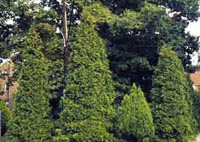Resource Library
Plant of the Week: Eastern Arborvitae
The University of Arkansas System Division of Agriculture does not promote, support or recommend plants featured in "Plant of the Week." Please consult your local Extension office for plants suitable for your region.
Plant of the Week
Eastern Arborvitae
Latin: Thuja occidentalis

Plant names come in several flavors. While common names are the most popular flavor amongst gardeners, it’s difficult to completely avoid more technical names. Sometimes gardeners are tricked into using these dreaded Latin names and don’t even know they have been duped. The evergreen tree, Arborvitae (Thuja occidentalis) is such a case.
Arborvitaes are slow growing needle-leaf evergreen trees or shrubs that come in a bewildering array of shapes and sizes. The largest selections attain 25 feet in height. While young, the plant has an upright character, but with age they tend to spread in the middle, usually becoming a third as wide as tall.
Because arborvitaes are so easy to propagate by cuttings, more than 100 selections have been made of this native American tree. About a forth of the cultivars have golden foliage or some form of variegation. Another quarter are slow growing plants suitable for the rock garden or dwarf conifer collection. The remaining group varies from round globes to tall screening plants, depending on the selection.
The Eastern Arborvitae is native to the upper reaches of the North Woods and is most abundant in a belt from Manitoba to Nova Scotia. As Thoreau described it, arborvitaes prefer "mossy and moosey" locations along the riverbanks and streams. It comes southward at higher elevations in the Appalachians.
Arborvitae is a Latin name given to the tree by 16th century French botanists who first described it for science. The name means "tree of life," and therein lies the tale of its discovery.
In 1536, the French explorer Jacques Cartier (1491 - 1557) was sailing up the St. Lawrence River with a crew of 110 seamen and a pair of native youths he had picked up on his first voyage to modern day Canada two years earlier. He was looking for the famed Northwest Passage to China and made it as far upriver as possible.
After the sea crossing and the trip inland, the crew was suffering from scurvy, the vitamin C deficiency, which causes bleeding gums and tooth loss, bleeding under the skin, extreme fatigue and often death. On his way upriver, he left the two natives in their home village, expecting neither to survive the serious scurvy attack, which had beset them during the Atlantic crossing.
In his journal, Cartier described the condition of Domagaia, the younger of the two boys as "very sicke and his knees swollen as bigge as a cild of two years old, and all his sinews shrunken together, his teeth spoyled."
After ten days absence he returned to the Huron village of Stadacona - today the site of Quebec - and found the two boys alive and well and fully recovered. On seeing their speedy recovery, he appealed to the boy to show him how the cure was achieved.
Shortly Cartier was presented with several branches of the evergreen tree and told how to chop and boil the leaves to extract the elixir that would cure the crew.
On his return France he took with him this North American tree, the first to be introduced to Europe. Thus the tree of life, or Arbor vitae, became known for a short time for its curative properties until the more tasty and easily transported citrus fruits took its place as a scurvy cure.
‘Emerald,’ ‘Techny’ and ‘Wintergreen’ are some of the best upright forms for screening. ‘Woodwardii’ and ‘Hetz Midget’ are good dwarf, globe-shaped forms.
All should be planted in full sun in a reasonably fertile soil that can be watered during periods of summer drought. An Achilles heel of the arborvitae is its susceptibility to bagworms, which must be scouted for each May to ensure they don’t become too numerous.
By: Gerald Klingaman, retired
Extension Horticulturist - Ornamentals
Extension News - November 9, 2002
The University of Arkansas System Division of Agriculture does not maintain lists of retail outlets where these plants can be purchased. Please check your local nursery or other retail outlets to ask about the availability of these plants for your growing area.